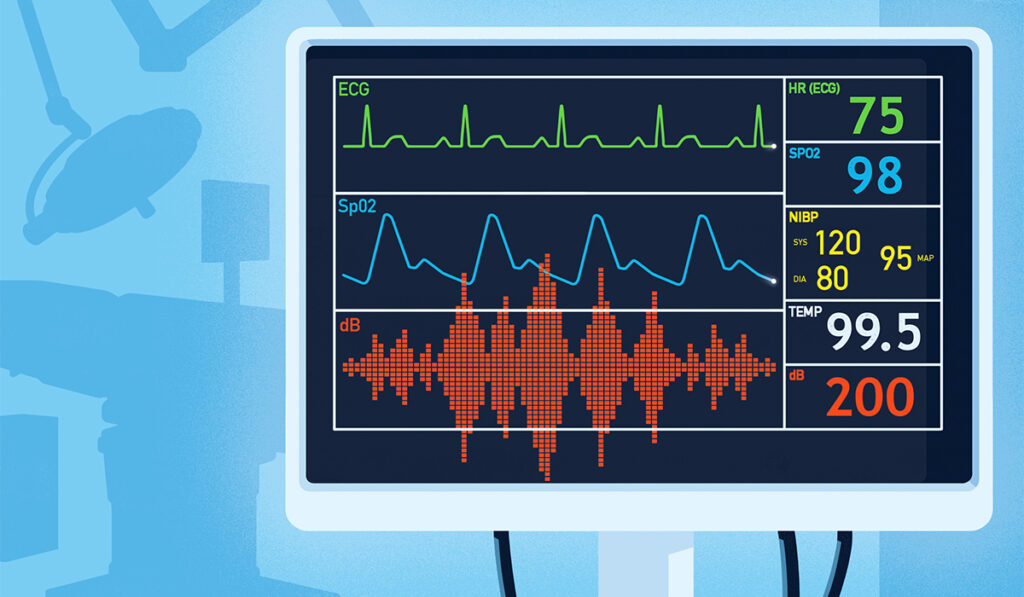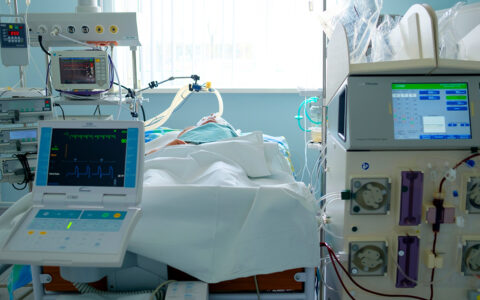A device that automatically modulates music volume in the operating room promotes a faster medical response and better communication among members of the clinical team, a new study has found.
The device, marketed as the CanaryBox, is intended to avert potentially dangerous outcomes for patients by managing volume levels according to set parameters, said Joseph Schlesinger, M.D., an associate professor of anesthesiology at Vanderbilt University Medical Center and the senior author of an article about issues related to operating-room sound levels published in Human Factors in Healthcare.
“All staff members in the OR need the proper environment.”
“All staff members in the OR need the proper environment,” Schlesinger said. “There’s some evidence that music played at a moderate volume helps surgeons if it’s a genre they are familiar with. But there’s not much research about the effects of volume on anesthesiologists, circulators, nurses and other technical specialists.”
Use of the name CanaryBox harkens back to the historic use of canaries in coal mines to warn miners of dangerous fumes, he said. When the canaries died, miners knew it was time to evacuate.
Sound Effects Mixed
In most cases, the patient is sedated or unconscious and typically the least affected person in the room by noise, the researchers noted.
But for the surgeon, hearing favorite songs may help improve the speed with which certain tasks are executed, according to previous studies. Some indicate it provides a more relaxing atmosphere for staff. But the overall effects of playing music in the OR space are still under debate.
Loud music in the OR became a concern only after streaming music became popular, Schlesinger said. Prior to streaming services, OR protocol usually called for the anesthesiologist on duty to control the volume of music on a cassette or CD player, and they generally kept things at a lower volume.
When streaming services emerged, surgeons took greater control over the music, and co-worker concerns were raised about difficulty of communication and other issues, he said.
Cacophony in the OR
Total noise levels in the OR often surpass 130 decibels – volume typical of a busy highway – with sounds emanating from various machines, testing equipment and conversations, the authors note. In 53- to 72-percent of surgeries, music adds to the aural environment, contributing up to 87 additional decibels. The U.S. Environmental Protection Agency has identified 45 decibels as the highest average level of indoor sound that still allows spoken conversation, work and collaboration.
Meanwhile, two of the 2021 national safety goals for hospitals set by the Joint Commission are to “use alarms safely,” in reference to a speedy and appropriate response to alarm signals, as well as to “improve staff communication.” Both those goals may be threatened by excessively loud music in the operating room, the researchers point out.
Individualized Data
The CanaryBox device is about the size of a small purse or iPad and receives data from patient vital sign monitors while also gauging sound levels throughout the room.
The researchers’ quality improvement project was intended to see if response times to operating room alarms could be improved by better management of competing sounds. To do so, they collected data on 12 control surgeries, which took place without a sound modulating device. They also examined data from 58 surgeries that used the device. All were pediatric orthopedic procedures.
The device was set to trigger an alarm to indicate excessive sound levels and to reduce the volume of music gradually to 50 percent of its former level. The volume would be later restored. In more extreme cases, a second alarm could be triggered that would silence the music for the duration of the procedure.
Results included data on how long it took the anesthesiologist to respond after the onset of a vital-sign alarm.
Enhanced Responses
When the CanaryBox was monitoring and controlling for loud sounds in the OR, alarm response times by anesthesiologists were reduced: pre-intervention 29.4 seconds; post-intervention 18.9 seconds. There were also reductions in average anesthesia provider alarm response time – pre-intervention 30.2 seconds; post-intervention, 23.6 seconds.
Schlesinger said he and Gururaja are undertaking a similar but larger study involving 100 controls and 100 interventions. That study will include a wider variety of surgeries and patients.
“When that larger study is done, we will understand clearly what the device is able to do and how it is affecting OR dynamics,” Schlesinger said.
Both studies build on Schlesinger’s work to raise awareness about human factors related to critical auditory stimuli, which draws lessons from music and aviation.
Operations, Step by Step
Though anesthesiologists must have the highest degree of focus when the patient is going to sleep and waking up, the surgeon may be relatively idle at those times, Schlesinger said.
Meanwhile, the surgeon must be more deeply engaged during the procedure than the anesthesiologist. He called it “the yin and yang” of focus in the operating theater.
“We want anesthesiology and surgery to come together in a unified way, in the best interests of the patient.”
“We want anesthesiology and surgery to come together in a unified way, in the best interests of the patient. Our research is meant to engender the discussion of music in the OR,” Schlesinger said.





